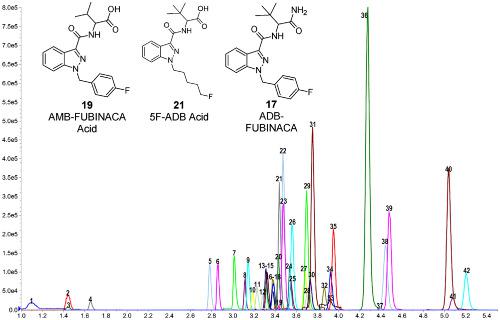当前位置:
X-MOL 学术
›
Drug Test. Anal.
›
论文详情
Our official English website, www.x-mol.net, welcomes your
feedback! (Note: you will need to create a separate account there.)
Simultaneous analysis of 29 synthetic cannabinoids and metabolites, amphetamines, and cannabinoids in human whole blood by liquid chromatography-tandem mass spectrometry - A New Zealand perspective of use in 2018.
Drug Testing and Analysis ( IF 2.6 ) Pub Date : 2019-11-28 , DOI: 10.1002/dta.2697 Rui Shen Ong 1 , Diana C Kappatos 1 , Sarah G G Russell 1 , Helen A Poulsen 1 , Samuel D Banister 2, 3 , Roy R Gerona 4 , Michelle Glass 5 , Cameron S Johnson 6 , Mary-Jane McCarthy 1
Drug Testing and Analysis ( IF 2.6 ) Pub Date : 2019-11-28 , DOI: 10.1002/dta.2697 Rui Shen Ong 1 , Diana C Kappatos 1 , Sarah G G Russell 1 , Helen A Poulsen 1 , Samuel D Banister 2, 3 , Roy R Gerona 4 , Michelle Glass 5 , Cameron S Johnson 6 , Mary-Jane McCarthy 1
Affiliation

|
We describe the validation of a method for the simultaneous analysis of 29 synthetic cannabinoids (SCs) and metabolites, 4 amphetamines, and 2 cannabinoids in human whole blood. This method enables one analysis to cover what previously required multiple analyses for these classic and novel drugs‐of‐abuse with diverse physicochemical properties. The scope of targeted analytes was based on the most prevalent drugs‐of‐abuse and SCs encountered at the New Zealand border in 2017 and included parent compounds and metabolites belonging to the indole and indazole carboxamide, quinolinyl indole carboxylate, and naphthoylindole classifications. Samples were prepared by supported‐liquid‐extraction (SLE) followed by liquid chromatography−tandem mass spectrometry (LC−MS/MS) analysis with positive electrospray ionization (ESI). The method was validated with respect to selectivity, matrix effects, process efficiency, sensitivity, repeatability, extract stability, and carryover for qualitative confirmation. Linearity as well as accuracy and precision data at target decision concentrations were also evaluated. The limits of detection and confirmation ranged from 0.1 to 6.0 ng/mL and 1.0 to 6.0 ng/mL, respectively. The described method was successfully applied to the analysis of 564 ante‐ and post‐mortem blood samples in 2018. There were 132 cases (23%) with positive findings of at least one SC, with the five most commonly detected SCs being AMB‐FUBINACA and/or acid (61%), 5F‐ADB and/or acid (40%), ADB‐FUBINACA (11%), 5F‐MDMB‐PICA acid (6%), and MDMB‐FUBINACA acid (6%). The results also demonstrate the predominant presence of metabolites at higher levels than the unchanged parent SCs in blood, highlighting the need to maintain forensic screening methods capable of the simultaneous detection of both parent compounds and metabolites.
中文翻译:

液相色谱-串联质谱法同时分析人全血中29种合成大麻素和代谢产物,苯丙胺和大麻素-新西兰在2018年的使用前景。
我们描述了一种用于同时分析人类全血中29种合成大麻素(SCs)和代谢物,4种苯丙胺和2种大麻素的方法的验证。这种方法使一项分析能够涵盖以前需要对具有多种理化特性的这些经典和新颖滥用药物进行多次分析的内容。目标分析物的范围基于2017年在新西兰边境遇到的最普遍的滥用药物和SC,包括吲哚和吲唑羧酰胺,喹啉基吲哚羧酸盐和萘甲吲哚的母体化合物和代谢物。样品通过支持液萃取(SLE),液相色谱-串联质谱(LC-MS / MS)和正电喷雾电离(ESI)进行制备。该方法在选择性,基质效应,工艺效率,灵敏度,可重复性,提取物稳定性和残留量方面进行了验证,以进行定性确认。还评估了目标决策浓度下的线性以及准确性和精密度数据。检测限和确认限分别为0.1到6.0 ng / mL和1.0到6.0 ng / mL。所描述的方法已成功应用于2018年的564份死前和死后血样分析。有132例(23%)至少有一个SC呈阳性结果,最常见的五个SC是AMB‐FUBINACA和/或酸(61%),5F-ADB和/或酸(40%),ADB-FUBINACA(11%),5F-MDMB-PICA酸(6%)和MDMB-FUBINACA酸(6%)。
更新日期:2019-11-28
中文翻译:

液相色谱-串联质谱法同时分析人全血中29种合成大麻素和代谢产物,苯丙胺和大麻素-新西兰在2018年的使用前景。
我们描述了一种用于同时分析人类全血中29种合成大麻素(SCs)和代谢物,4种苯丙胺和2种大麻素的方法的验证。这种方法使一项分析能够涵盖以前需要对具有多种理化特性的这些经典和新颖滥用药物进行多次分析的内容。目标分析物的范围基于2017年在新西兰边境遇到的最普遍的滥用药物和SC,包括吲哚和吲唑羧酰胺,喹啉基吲哚羧酸盐和萘甲吲哚的母体化合物和代谢物。样品通过支持液萃取(SLE),液相色谱-串联质谱(LC-MS / MS)和正电喷雾电离(ESI)进行制备。该方法在选择性,基质效应,工艺效率,灵敏度,可重复性,提取物稳定性和残留量方面进行了验证,以进行定性确认。还评估了目标决策浓度下的线性以及准确性和精密度数据。检测限和确认限分别为0.1到6.0 ng / mL和1.0到6.0 ng / mL。所描述的方法已成功应用于2018年的564份死前和死后血样分析。有132例(23%)至少有一个SC呈阳性结果,最常见的五个SC是AMB‐FUBINACA和/或酸(61%),5F-ADB和/或酸(40%),ADB-FUBINACA(11%),5F-MDMB-PICA酸(6%)和MDMB-FUBINACA酸(6%)。









































 京公网安备 11010802027423号
京公网安备 11010802027423号